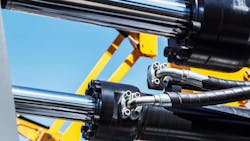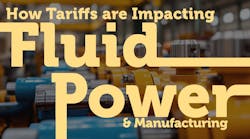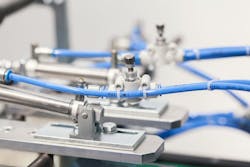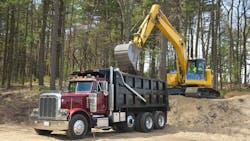Early Signals Indicate Growth for Fluid Power Industry in 2026
Key Highlights
- A level of economic uncertainty is likely to continue into 2026, but there are some signals, such as the potential for further interest rate cuts, pointing to improved market conditions next year.
- Shipments and orders for fluid power products have started to stabilize, providing an early indicator of potential upward moment for the hydraulics and pneumatics industry in 2026.
- Key customer markets such as construction, agriculture, and manufacturing are showing signs of recovery which would help drive growth for the fluid power industry.
Market challenges persisted again in 2025 for the fluid power industry and many of its customer segments. Although many were predicting improved economic conditions after a difficult 2024, that did not turn out to be the case.
U.S. trade policy has been one of the biggest factors. Jim Meil, Principal, Industry Analyst at ACT Research, said during the National Fluid Power Association’s (NFPA) fall economic webinar it has been a headwind for long-term business investment as it continues to bring uncertainty, especially for those in durable goods sectors, of which fluid power is a part.
Tariff rates, what items are subject to this tax, and the exporting countries impacted frequently changed throughout 2025 — sometimes on a daily basis — making business planning difficult and thus preventing many from investing in new machinery and other goods.
“The shifting landscape of trade policies adds complexity to our sourcing and manufacturing decisions, especially in cross-border production,” representatives from Camozzi Automation – USA branch told Power & Motion. “That said, our global diversified footprint helps buffer some of that risk.”
View the below content to learn more about how tariffs have been impacting the fluid power and other related industries.
“The market dynamics of unpredictable tariffs have caused issues for both our customers and us,” said Frank Langro, Director – Product Market Management, Pneumatic Automation, North America, Festo, in an interview with Power & Motion. “Cost structures were turned on their heads as supply chains had to be thoroughly re-evaluated to understand the impact of the tariffs. This had to be done down to raw materials, not simply components and finished goods.
“2025 has been a volatile year for the fluid power industry,” he continued. “The only consistency we’ve seen is the continued unpredictability of the market.”
After a year of volatility, will 2026 be the same? That remains to be seen, but Meil said there are some signs of upward momentum starting to show, including:
- stabilizing fluid power shipments and orders
- additional interest rate cuts
- potential recovery in some customer markets.
These and other factors are providing early signals that 2026 may be a growth year for the fluid power industry.
Fluid Power Shipments and Orders are Stabilizing, Offering Hope for Future Growth
Power & Motion has been conducting a survey to gauge the fluid power industry’s thoughts on how 2025 has performed and expectations for 2026. The majority of those who have responded so far indicated they anticipate market conditions to improve in 2026.
Agricultural machinery is the market segment they foresee providing the most opportunities, followed closely by construction equipment, semiconductor production and manufacturing equipment.
Take our survey below to provide your thoughts on the state of the fluid power industry in 2025 and expectations for 2026.
Survey respondents may have reason for this optimism as Meil said during the NFPA fall economic webinar that the downturn the fluid power industry has been experiencing since late 2022 through early 2025 may be coming to an end. Both orders and shipments appear to be stabilizing, though he did caution it is still “early-stage green shoots.”
The numbers for U.S. Total Fluid Power orders and shipments have broken the declining trend they have been in for the past 3-1/2 years and have essentially been moving in a flat direction, he said, which may be setting the stage for a better 2026.
For total pneumatic shipments and orders, Meil said there are early signs of an upturn and orders in particular are starting to stabilize. A similar picture can be seen for total hydraulics as well which he said has experienced an even stronger upward trend so far in 2025 with shipments starting to follow a similar pattern.
Meil emphasized that there is still a lot of uncertainty and no guarantees upward momentum will continue, but these stabilizations in orders and shipments offer early signs of hope and “is the kind of trend you want to see.”
He also noted the upward momentum may not match what was seen in 2021 post-COVID, but at least it is headed in the right direction.
Economic Factors and Customer Markets to Watch in 2026
Although there is still a lot of uncertainty going into 2026, Meil said things are looking more promising right now than they have in the past six to seven quarters which is helping expectations for growth in 2026.
Visit our Market Trends channel for even more content related to economic and technology trends impacting the fluid power and electromechanical motion control sectors. You can also sign up for our Market Trends eNL to have this content delivered directly to your inbox.
A further lowering of interest rates by the U.S. Federal Reserve (the Fed) will play an important role in how 2026 pans out. Meil said if these occur, it will lead to lower financing costs which benefits those in durable goods industries as it makes it more feasible for businesses and consumers alike to make large purchases — increasing demand for various goods like machinery, cars and the components utilized in them.
The Fed is scheduled to meet in December; the chances of a rate cut during this meeting are uncertain, but Meil said it is likely cuts will come in future months whether or not one is made in December.
In addition to the lowering of interest rates, there are some key fluid power customer markets which Meil and others see potentially contributing to a turnaround for the hydraulics and pneumatics industry in 2026.
Construction Equipment
According to Meil, a rebound is taking shape in the U.S. construction equipment market. When looking at the orders trend for this sector, he said there has been a year-long jump in orders.
Meil noted the current data center boom as a growth driver for this sector. Rising use of artificial intelligence (AI) and other data-intensive applications is prompting the buildup of data centers around the world and the U.S. in particular. Excavators, dump trucks and other construction equipment are needed to build the infrastructure required by these facilities, leading to increased demand for machinery as well as the hydraulics and other components utilized within them.
Ken Baker, CEO of Bailey, to Power & Motion that construction has increased as a percentage of Bailey’s business and expects that to continue. “Non-residential construction appears to be stable,” he said, due in part to the boom in data centers, which is benefitting the construction equipment industry and suppliers to it like Bailey.
Housing continues to present uncertainty though because of high mortgage rates and material costs, among other factors. If more interest rate cuts are made in the coming months, it could help the housing market.
Baker said he is hopeful that lower interest rates and a focus on reducing regulatory overhead will increase construction activity for residential and multi-family housing, and that it will lead to improved demand in both the forestry and construction equipment sectors.
Read more of Baker, Langro and Camozzi Automation's insights on the market and technology trends they see influencing the fluid power industry in 2026 in the article "Fluid Power Industry Continues to Navigate Market Challenges While Embracing New Opportunities."
Agricultural Machinery
It has been a difficult year for the U.S. agricultural equipment market, with sales down for much of 2025, particularly for larger machine types. The latest data from the Association of Equipment Manufacturers (AEM) shows total tractor sales declined 19.6% in October while combine sales fell 26.8%.
Per AEM’s October 2025 Ag Tractor and Combine Report, year-to-date retail sales for tractors are down 9.2% from 2024 and for combines 38.4%.
Meil said if a trade deal is reached with China, it could help turn things around for the industry. On Nov. 1, the White House announced it reached a trade deal with China which includes the country agreeing to purchase soybeans and other agricultural products from the U.S. once again.
This would greatly benefit farmers’ incomes and their ability to invest in new machinery as China has typically been one of the largest consumers of U.S. agricultural products, particularly soybeans. However, Barron’s reports that as of Nov. 14, China has bought just under 3% of the soybeans it pledged to purchase by January 2026. So for now, the industry must wait and see if China does follow through with its commitment to purchase more agricultural products.
Baker said he expects agricultural equipment markets to continue struggling through the first half of 2026. Even if China does increase its purchasing of soybeans and other crops, it will take time for this to positively impact the industry.
He said replacement and repair components are likely to be key drivers for this sector in early 2026. This is because maintaining equipment to keep it operational will be the more affordable option for farmers until market conditions improve.
Industrial and hydraulic hose service provider PIRTEK has seen steady demand for its hose services in 2025, and in the third quarter achieved record growth. The company is anticipating this demand to persist into 2026 as customers in various mobile and industrial markets as activity increases and an emphasis continues to be placed on maintaining equipment.
Manufacturing Technology
The industrial sector started 2025 on a better note than many of its mobile machinery counterparts, but as tariffs and other factors took hold it too began to experience challenging conditions.
Langro noted that Festo, which serves a range of industrial applications, had a strong start to the year, but experienced a slowdown starting in the second quarter. “Recently, we have seen a positive uptick and are cautiously optimistic for 2026,” he said.
Cautious optimism was the theme of AMT – The Association for Manufacturing Technology’s MTForecast 2025 event as well. As AMT reports, slower growth is currently projected for global industrial output in 2026 and uncertainty caused by trade policies and various geopolitical factors is likely to prevail.
The association’s most recent U.S. Manufacturing Technology Orders Report (USMTO) shows new orders for metalworking machinery in September 2025 were down compared to those in August but 11% above the year-ago level. While this sector has so far been able to weather market conditions in 2025, AMT said the number of units ordered is growing at a slower pace.
AMT said orders from automotive manufacturers increased in September, likely due to some OEMs retooling production lines away from electric vehicles (EV).
As EV market adoption grew in recent years, it was thought they would eventually eliminate the need for traditional metal bending and machining technology in the automotive industry said Meil. But changes in governmental policy have essentially sidelined EVs, he said, which is breathing new life into internal combustion engines and the machine tools and other machinery used to produce them — and thus potentially a good sign for the fluid power companies that supply the metalworking machinery sector.
Read the following articles to learn more about the opportunities semiconductors, data centers and the Life Sciences market are bringing to the fluid power industry.
Automation Uptake in Life Sciences Brings Market Opportunities
Festo Brings Automation Expertise to Life Sciences Industry
Why Pneumatics are a Good Fit for Semiconductor Production
Hydraulics and Pneumatics Play Important Role in Data Center Cooling
Automation remains an opportunity area for the industrial sector Langro noted. Manufacturers and others continue to deal with labor shortages, increasing demand for automation solutions.
Semiconductor production and the Life Sciences market are two of the sectors where he sees uptake of automation bringing opportunities in the coming year because of the increased activity taking place in these sectors and the need to quickly produce quality goods. Data centers are another area where he sees use of automation to support ancillary systems increasing and thus providing potential opportunities in the future.
There are still a lot of ‘ifs’ going into 2026, but overall, Meil said he believes there is legitimate reason to see some sustained upturn in 2026 for the hydraulics and pneumatics industry, particularly if there is a lowering of interest rates, the construction equipment sector participates in the AI boom and China resumes purchasing of agricultural products.
About the Author
Sara Jensen
Executive Editor, Power & Motion
Sara Jensen is executive editor of Power & Motion, directing expanded coverage into the modern fluid power space, as well as mechatronic and smart technologies. She has over 15 years of publishing experience. Prior to Power & Motion she spent 11 years with a trade publication for engineers of heavy-duty equipment, the last 3 of which were as the editor and brand lead. Over the course of her time in the B2B industry, Sara has gained an extensive knowledge of various heavy-duty equipment industries — including construction, agriculture, mining and on-road trucks —along with the systems and market trends which impact them such as fluid power and electronic motion control technologies.
You can follow Sara and Power & Motion via the following social media handles:
X (formerly Twitter): @TechnlgyEditor and @PowerMotionTech
LinkedIn: @SaraJensen and @Power&Motion
Facebook: @PowerMotionTech

Leaders relevant to this article:







